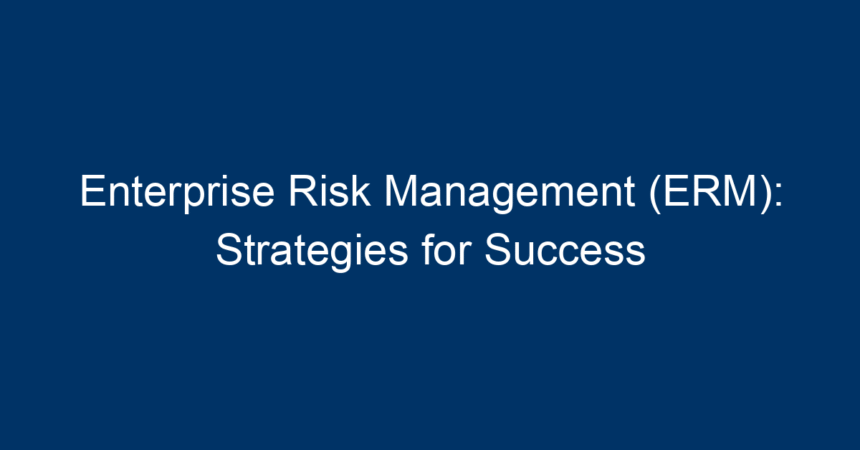In today’s fast-paced business environment, the need for robust Enterprise Risk Management (ERM) has never been more crucial. Companies face various risks ranging from financial uncertainties to technological disruptions. Effective ERM is not just about mitigating threats; it’s also about seizing opportunities for sustainable growth. In this article, we will explore key strategies for successful Enterprise Risk Management, providing actionable insights to ensure your organization thrives amidst uncertainty.
Understanding Enterprise Risk Management (ERM)
What is ERM?
Enterprise Risk Management (ERM) is a comprehensive approach employed by organizations to identify, assess, manage, and monitor risks that could hinder their ability to achieve objectives. ERM integrates risk management practices into an organization’s core processes, aligning them with strategic goals and ensuring that risk considerations are embedded in decision-making at all levels.
Importance of ERM
The importance of ERM cannot be overstated:
- Holistic View: ERM encourages organizations to take a comprehensive view of risks, considering both internal and external factors.
- Regulatory Compliance: With evolving regulations, effective ERM helps businesses comply with legal requirements and avoid penalties.
- Competitive Advantage: By proactively managing risks, organizations can identify new opportunities, leading to innovation and competitive positioning.
Key Components of an Effective ERM Framework
To implement Enterprise Risk Management successfully, organizations must focus on essential components of an effective ERM framework.
Risk Identification
Identifying risks is the cornerstone of any ERM strategy. Organizations should conduct thorough risk assessments to uncover potential threats, which can include:
- Market Risks: Fluctuations in market conditions that can affect revenue.
- Operational Risks: Internal process failures that can disrupt business activities.
- Compliance Risks: Risks arising from violations of laws and regulations.
Risk Assessment
Once risks are identified, organizations need to assess their potential impact and likelihood. A risk matrix can be a valuable tool for prioritizing risks based on their severity and probability. This assessment should involve:
- Qualitative Analysis: Understanding the nature and context of risks.
- Quantitative Analysis: Using metrics and data to evaluate risk exposure.
Risk Response Strategies
Organizations must develop strategies to respond to identified risks effectively. Common risk response strategies include:
- Avoidance: Eliminating activities that expose the organization to risk.
- Mitigation: Implementing measures to reduce the impact or likelihood of risks.
- Transfer: Shifting the risk to a third party, such as through insurance.
- Acceptance: Accepting the risk when the benefits outweigh potential downsides.
Risk Monitoring and Reporting
An effective ERM framework requires ongoing monitoring and reporting of risks. Organizations should establish key risk indicators (KRIs) to track risk exposure and changes. Regular risk assessments and updates to the risk management plan are essential to ensure alignment with organizational objectives.
Strategies for Implementing Successful ERM
Implementing an effective ERM framework requires a strategic approach. Here are some best practices to ensure success:
Foster a Risk-Aware Culture
Organizations must cultivate a culture that promotes awareness of risks at all levels. This involves:
- Training: Providing employees with the necessary training to identify and manage risks.
- Communication: Establishing clear communication channels for reporting risks.
- Leadership Support: Leadership must champion risk management initiatives, demonstrating their importance to the organization.
Utilize Technology and Tools
Leveraging technology can enhance the effectiveness of ERM programs. Consider adopting:
- Risk Management Software: Tools that streamline risk assessments and reporting processes.
- Data Analytics: Utilizing big data to identify trends and predict potential risks.
- Collaboration Tools: Platforms that foster collaboration across departments for holistic risk management.
Engage Stakeholders
Stakeholder engagement is critical for a successful ERM implementation. Involve key stakeholders, including:
- Board of Directors: Ensuring oversight and strategic direction.
- Employees: Engaging staff from all levels to gain insights into potential risks.
- External Partners: Collaborating with insurance providers, consultants, and regulators for comprehensive risk assessments.
Measuring ERM Effectiveness
To ensure the effectiveness of your ERM initiatives, it’s crucial to measure success regularly. Consider the following metrics:
- Risk Reduction: Evaluate the decrease in identified risks over time.
- Compliance Rates: Monitor adherence to regulatory requirements.
- Incident Tracking: Keep records of risk events and responses to assess improvements.
Creating feedback loops through regular reviews can help refine the ERM process, ensuring continuous improvement.
Challenges in ERM Implementation
While the benefits of Enterprise Risk Management are substantial, organizations may face several challenges during implementation, including:
- Resource Constraints: Limited budgets or personnel may hinder effective ERM initiatives.
- Resistance to Change: Employees may resist new processes, impacting compliance.
- Complexity of Risks: The rapidly evolving landscape of risks can make it difficult to keep ERM strategies up to date.
To overcome these challenges, organizations should foster open dialogue, invest in training, and maintain flexibility in their ERM initiatives.
Conclusion
Enterprise Risk Management (ERM) is an essential component of organizational resilience. By adopting a structured framework, fostering a risk-aware culture, and utilizing technology, businesses can effectively manage risks and seize opportunities. Remember, successful ERM requires ongoing commitment from leadership and engagement from all employees.
As you move forward with your ERM strategies, always prioritize the integration of risk management into everyday business practices. With these actionable insights in hand, your organization will be well-equipped to navigate the complexities of the modern business landscape and emerge stronger in the face of uncertainty.
Take Action: Start assessing your current risk management practices, identify gaps, and develop a tailored ERM strategy that aligns with your organization’s objectives. The future success of your organization may depend on it.




